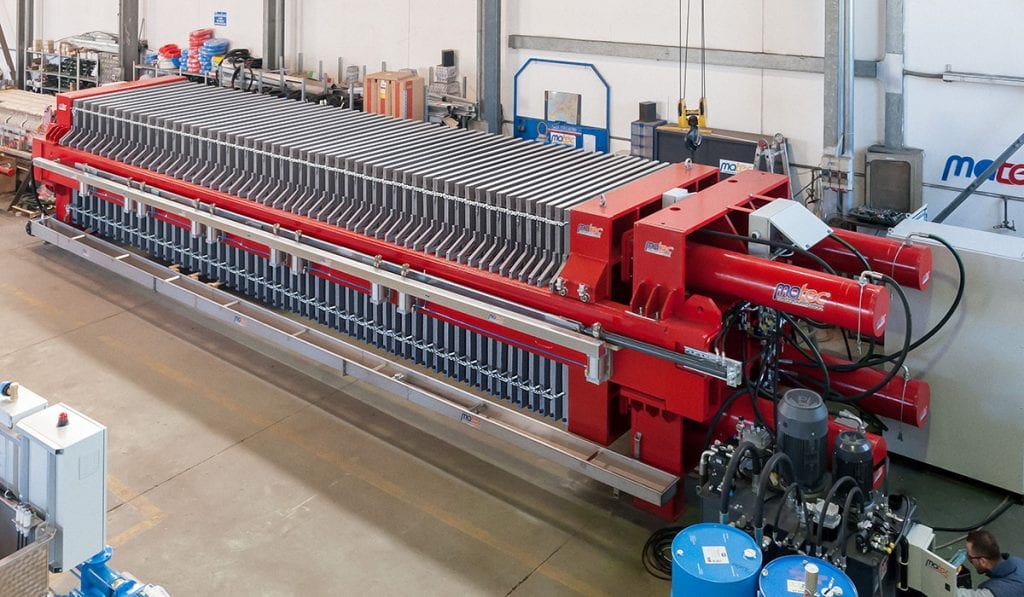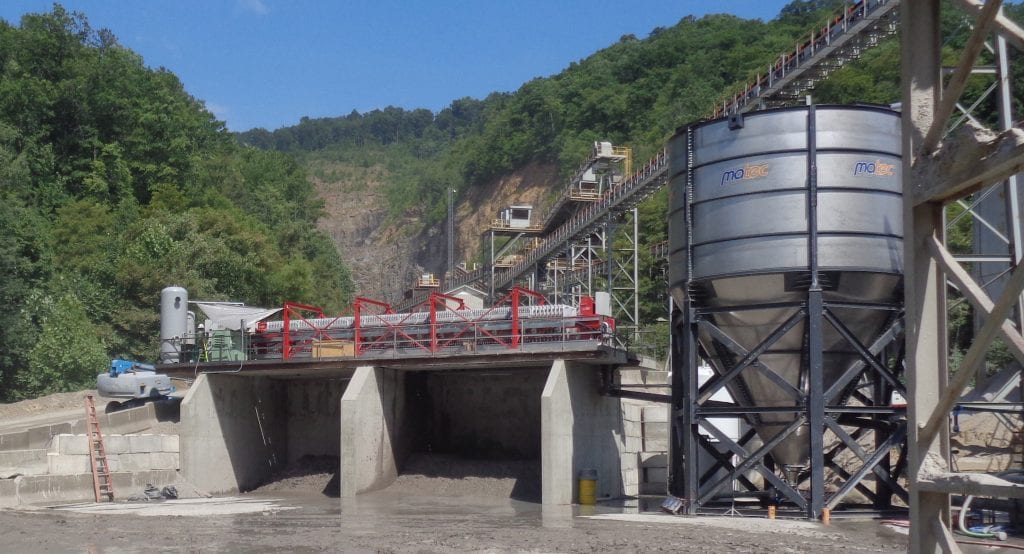What Is A Frame Filter Press
A filter press is one of the oldest and about trusted pieces of dewatering equipment. It's used for wastewater handling across a variety of industries and applications. A filter printing works by separating out solids from liquids, removing impurities, and suspended solids from industrial wastewater. This allows found managers to easily handle and dispose of waste matter while returning clean water to their systems.
Filter presses separate liquids and solids. Specifically, the filter press separates the liquids and solids using pressure filtration across a filter media. Afterward, the slurry is pumped into the filter printing and then dewaters nether pressure level.
What are the Four Main Components of a Filter Press?
- Frame
- Filter Plates
- Manifold (pipage and valves)
- Filter Cloth (This is cardinal for optimizing filter printing operations.
Basically, the filter press design is based on the dewatering book and blazon of slurry. ChemREADY is an expert in liquid and solid separation and offers a broad range of filter press types and capacities to suit specific awarding needs for trouble-free, economical dewatering.
View Our Filter Press Products
Filter Press History: From Beyond the Pond to Over It
The origin of the filter press dates to around the mid-19th century in the Great britain, where a rudimentary form of the press was used to obtain vegetable oil from seeds. Nevertheless, it wasn't until major developments in the mid-20th century that engineers were able to develop the world's starting time automatic horizontal-type filter press.
It's this long history of advancements that's allowed the filter presses of today to accomplish significantly lower free energy and maintenance costs compared to their belt press and centrifuge counterparts. In fact, the full operating filtration cost for a filter press can hands be 1/6 the cost of what it would be for a belt press or centrifuge.
While in that location are many dissimilar styles of modern filter presses, the plate and frame filter press are 1 of the oldest and about tested types of dewatering equipment available. You can read more than on this type of filter printing, along with a more detailed comparing between unlike types of dewatering equipment, in our Water Facts weblog on How Industrial Wastewater Pretreatment Works.
Filter presses are especially useful as the leftover solids are cheaper and easier to move than the entire slurry. With the clean water that filter presses render, plant managers can discharge that to their local municipalities, watersheds or utilize the water in their own closed-loop systems, creating highly efficient processes.
Common filter press applications include:
- Mining operations and aggregate
- "Ready-mix" concrete washout water recovery
- Food & drink production
- Marble and stone cut
Without a filter press or similar pieces of dewatering equipment, a settling pond is frequently the commencement choice for water treatment. Not only do ponds require a big amount of existent estate to apply, just they as well lose their power to clean water over time equally the solids that you remove build upwardly in the swimming water. This gives ponds an unfavorable long-term ROI as dingy water will eventually first coming back into your process unless you dredge the pond or make a new pond. At ChemREADY, we advise the utilise of a filter printing and other dewatering equipment over a pond in well-nigh applications.

How does a Filter Press Work?
During the fill cycle, the slurry pumps into the filter printing and distributes evenly during the fill cycle. Solids build up on the filter cloth, forming the filter cake in the void volume of the plate. The filtrate, or clean h2o, exits the filter plates through the ports and discharges clean h2o out the side of the plates.
Filter presses are a pressure filtration method. As the filter press feed pump builds pressure, the solids build within the chambers until they are completely total of solids. This forms the cake. The filter cakes release when the plates are full, and the cycle is complete. Also, many higher chapters filter presses use fast action automatic plate shifters which speeding cycle time. Matec specifically designs their filter presses for fully automatic, 24-60 minutes functioning in a harsh environment such as mines or chemical manufacturing plants for wastewater treatment.
What Is A Filter Press Used For?
While the diverse styles of filter presses piece of work differently, they all operate nether similar principles. Slurries of h2o mixed with solids are pumped into the press past using a feeding pump. Once within the press, pressure – oft from a centrifugal pump or similar device – pushes the slurry through chambers made of filter plates. This removes impurities from the water every bit "filter cakes" of solids build upwards on the car'southward filters.
Once the chambers of a filter printing are total, its filtration cycle is complete, and the machine releases the filter cakes. These cakes are easily removed, assuasive you to filter your water at high efficiencies. In filter presses, fast action automated plate shifters may be used to aid speed upwardly cake removal and bike fourth dimension. In harsher environments where continuous operation is required – like in mining processes or chemical manufacturing plants – a fully automated filter printing blueprint is needed to handle the 24-60 minutes workloads.
To get the best operation out of your filter press, the cloth of the filter should be specifically designed for your application and the types of solids that you are filtering.
The following tin besides be customized to fit your private needs:
- Car blueprint
- Filtration chapters
- Plate size and number of chambers
In addition to these, you tin use additional systems such as material washing systems, drip trays, and block shields to further increase filter press functioning and functionality. Ultimately, each filter printing should be designed based on the expected volume and type of slurry that it will be treatment.
Since filter presses work using pressure, equipment that increase pressure through the ways of high-pressure technology are great for optimizing your filter press system. That'southward the secret to success for Matec® filter presses, which utilise pressures of 21 to 30 bar to handle even the most hard and hard to treat slurries, no matter the sector or awarding.
Filter presses can be congenital in a wide range of sizes, from small, lab-calibration presses, to those with much larger capacities, such as those with 2000×2000 mm plates.
Many industries apply filter presses for liquid and solid separation, including:
- Nutrient and Drink Processing
- Chemical Manufacturing
- Mining
- Power Generation
- Aggregates
- Asphalt and Cement Production
- Steel Mills
- Municipal Plants
Combining Clarifiers and Filter Presses
While filter presses are great pieces of dewatering equipment, they are best used on a slurry made up of well-nigh 50-60 percent solids. Lower solids concentration requires running the water through a clarifier first.
Clarifiers are best described as large settling tanks, preferably used in the initial dewatering stage. Here, water tin enter at a much lower solids concentration, typically around 5-ten percent solids. Using gravity and polymers, clarifiers cause solids to build up at the bottom of the tank, where they can exist discharged equally sludge.
The ii main types of clarifiers are the horizontal rake style clarifier and the vertical deep cone clarifier. Vertical deep cone clarifiers utilize the principle of static decantation for a natural precipitation of solid material, while horizontal rake style clarifiers use a rake mechanism that stirs the sludge through rotation. Determining which type of clarifier is best for you depends on your clarifying needs, driven by maintenance costs, fabric types and solids requirements. You lot can read more on the two unlike types of clarifiers in our H2o Facts blog, Deep Cone vs. Rake Way Clarifiers.
When used in combination with each other, a clarifier and filter press can recover 90-95 percent of your water as clean h2o. The remaining water will belch with the solids from the filter press.

Full Water Treatment with ChemREADY
Here at ChemREADY, our team of water treatment experts can help bring your dewatering efforts together with a total water treatment that optimizes your systems. We can analyze your water from a chemical perspective to detect the correct flocculants, coagulants, and pH balancers that nosotros can used to care for your water before it goes through mechanical separation. This helps to optimize the operation of your clarifiers and filter presses, giving you a better and more efficient total h2o treatment.
Apart from our chemical products, we as well tin can aid go you setup with the best dewatering devices, including the Matec filter printing.
Compared to standard filter presses, the Matec filter press offers:
- Complete handling with existent automatic washing
- Fully automated systems
- Remote monitoring and assistance
- High-pressure technology (HPT) that works at 30 bar
- Open filtrate design, which allows for the unproblematic and rapid identification of bad filter cloths
- Perfect block discharge with gasser shakers
Are you running a smaller business and wondering if a filter press is right for y'all?
Read our useful Water Facts blog Can my Small Operation Afford a Filter Press? to learn more than.
What Is A Frame Filter Press,
Source: https://www.getchemready.com/water-facts/what-is-a-filter-press/
Posted by: tharpsandint.blogspot.com


0 Response to "What Is A Frame Filter Press"
Post a Comment